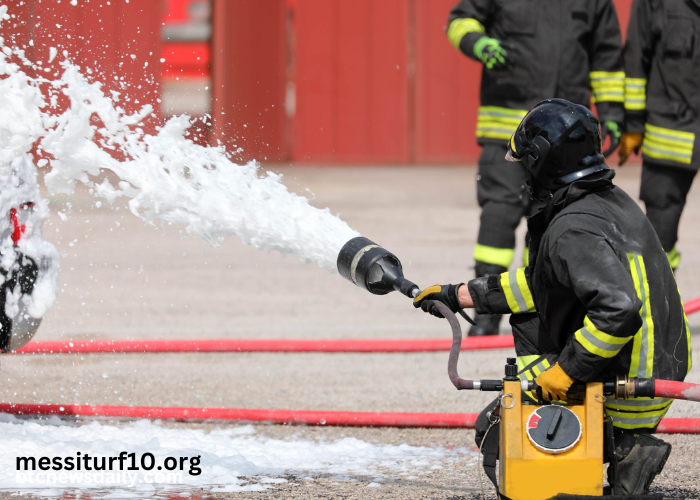On the surface, they rush headlong into danger to save lives. Below the surface, an insidious threat lies in wait, imperiling the lives of those who bravely battle blazes. For decades, firefighters have relied on Aqueous Film Forming Foam (AFFF.) Its key ingredients, Per- and Polyfluoroalkyl Substances (PFAS), are crucial tools for confronting liquid fuel fires.
Yet these chemical allies have proven to be a foe in disguise, suspected of endangering the same first responders they were designed to shield. As research uncovers more about PFAS’ potential toxicity, a sobering question emerges: how serious is the hidden health hazard lurking within the very substances keeping our firefighters safe? Let us find out.
How Does AFFF Help Firefighters?
Aqueous film-forming foam (AFFF) is an essential firefighting tool. AFFF contains fluorinated surfactants that allow it to extinguish liquid fuel fires more effectively than water alone. When sprayed onto a fire, AFFF forms an aqueous film that coats the fuel source. This film serves multiple purposes.
First, it cools the fuel and flames, helping to suppress combustion. AFFF reduces the rate at which the fire can spread by reducing the temperature. In addition, the film serves as a barrier to keep the fuel and oxygen in the air apart. The fire cannot continue to burn without a consistent source of oxygen.
The coating that AFFF produces is durable enough to prevent reignition even after the initial flames are put out. It denies the fuel the three elements needed for combustion – heat, fuel, and oxygen. This makes AFFF highly effective for extinguishing fires involving flammable liquids like gasoline, diesel, and jet fuel.
AFFF is commonly used by firefighters to combat industrial and marine fires where liquid fuel hazards are prevalent. The surfactants allow it to rapidly form the cooling and oxygen-proof film across large surface areas. This gives firefighters a powerful tool for bringing even large-scale liquid fuel fires under control safely and efficiently.
Why is Aqueous Film Forming Foam Toxic?
Firefighting foams that use certain chemicals as their active ingredients can potentially have harmful effects, especially those containing per- and poly-fluoroalkyl substances (PFAS). PFAS are a class of man-made compounds that have seen widespread use since the 1950s in many industrial and household applications.
Two specific PFAS found in older AFFF stocks or produced as breakdown products are perfluorooctane sulfonate (PFOS) and perfluorooctanoic acid (PFOA). While PFOA is not an intended ingredient in AFFF, it can be produced as a byproduct during manufacturing.
Many AFFF formulations also contain unintended PFAS byproducts that raise similar health and environmental issues.
Research shows that PFAS are toxic to humans and do not easily break down in the environment, waterways, wildlife, or the human body. Their widespread and persistent use has led to concerns about negative impacts on human health over long-term exposure.
Potential Health Risks of PFAS Exposure from Aqueous Film Forming Foam
According to TorHoerman Law, various bodies of research from reputable institutions have investigated potential health risks linked to per- and polyfluoroalkyl substances (PFAS) found in aqueous film-forming foam (AFFF).
PFAS, or “forever chemicals,” have been the subject of studies by the Environmental Protection Agency, National Research Council, Centres for Disease Control, and other organizations. These studies have looked at the links between PFAS and cancer and other health problems. Numerous important research investigated the relationship between cancer risk and exposure to PFAS.
The National Cancer Institute examined this potential link. A study in Environmental Health Perspectives looked at PFAS exposures in adults near a chemical plant and subsequent cancer incidents.
The Journal of Air & Waste Management performed a critical review on PFAS, such as perfluorooctanoic acid (PFOA) and kidney or testicular cancers. Environmental Research conducted a scoping review of epidemiological evidence tying PFAS to cancers. The EPA also summarized the current understanding of human and environmental health risks from PFAS.
These studies and ongoing litigation have specifically connected AFFF/PFAS exposure to various types of cancers.
Cancers potentially linked to exposure include bladder, breast, colon, kidney, liver, pancreatic, prostate, rectal, and testicular cancers, as well as lymphoma, leukemia, neuroendocrine tumors, and mesothelioma. According to firefighter foam cancer lawsuits, pancreatic, testicular, and prostate cancers seem to be the most common cancer types.
Individuals harmed by PFAS exposure are seeking damages through legal action against AFFF manufacturers. To address health difficulties related to PFAS contamination, claims cover medical expenditures, lost wages, pain and suffering, loss of quality of life, permanent impairment, and other compensatory and punitive costs.
Further research continues to advance understanding of PFAS toxicity and health impacts in an effort to protect human and environmental health better.
Regulatory Moves Support Transition to PFAS-Free Firefighting
The Federal Aviation Administration has authorized the use of firefighting foams by airports that do not contain per- and polyfluoroalkyl substances (PFAS), commonly called “forever chemicals.” This pivotal decision facilitates ending the use of PFAS-containing foams at military bases as mandated by Congress.
A firefighting foam free of fluorine has been added to the Qualified Products List by the US Department of Defense.
This synthetic fluorine-free foam is the first of its kind approved. It is currently the only fluorine-free foam available commercially.
In addition to being more environmentally friendly, test results indicate it performs equal to or better than aqueous film-forming foam in key areas. The areas include burning back, drain time, and expansion ratio.
Furthermore, this new foam is biodegradable and contains no intentionally added PFAS. It also works with various firefighting equipment systems currently in use.
These regulatory changes and approvals of effective PFAS-free alternatives represent important steps toward limiting PFAS exposure from firefighting activities. They aim to protect drinking water sources and public health while still providing necessary fire suppression capabilities.
FAQs
-
Do firefighters still use AFFF?
A: The law bans the use of AFFF for fire training, but it remains permissible for dealing with actual flammable liquid fires and emergencies.
-
What is the typical settlement for an AFFF lawsuit?
A: Drawing from past mass tort cases involving cancer, our legal team forecasts that AFFF firefighting foam cases falling within the top settlement tier will likely yield average settlement amounts ranging from $300,000 to $600,000.
-
Is it possible to file a VA claim for PFAS exposure?
A: Yes, the VA provides a toxic chemical risk assessment and is working on establishing a registry for individuals exposed to PFAS. You can submit a disability claim through the VA for any conditions you suspect are linked to PFAS exposure.
On the surface, firefighters are heroes who risk their lives to save others. However, the chemical tools relied upon to do so have proven dangerous in their own right.
As research increasingly links PFAS exposure to severe health impacts, these revelations shed light on a troubling irony. The substances relied upon to enhance firefighter safety may be undermining it.
While the transition to PFAS-free alternatives has begun, more remains to be done to safeguard those who safeguard us from the perils of fire.




